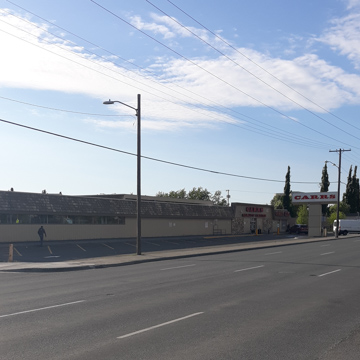Before becoming a statewide grocery chain, Carrs was a rundown Quonset hut at what was then the southern edge of town, East 14th Avenue and Gambell Street. In 1950, Larry Carr bought the failing grocery housed there for $15,000. The original staff numbered just six people, including Carr himself, his brother, sister-in-law, two high schoolers, and Carr's future wife.
In 1952, Larry Carr opened a new Carrs store on the same location as the original, which, in 1954 grew into the Eastchester Shopping Center. The Center originally contained Carrs, a hardware store, dress shop, service station, and Eastchester Drugs. The Eastchester neighborhood was renamed Fairview prior to the Shopping Center opening. Eastchester Drugs kept the name while the center later became the Fairview Shopping Center. Carr ordered more than 200 tons of merchandise for the 1954 grand opening. By that time, he had expanded his operation to net $700,000 in annual sales. Carr had also added a fresh fish market and bakery within the grocery store, and employed 47 workers. The location, situated parallel to Gambell Street in a highly trafficked section of town, contributed to Carr's success. It remains a fixture in the Fairview neighborhood and is one of the longest operating grocery stores in Anchorage.
Disaster struck the Carrs grocery store not even three years after it opened. On February 1, 1957, a fire gutted the grocery store's interior, though firefighters and firewalls managed to prevent significant damage from spreading to the other stores in the Fairview Shopping Center. None of the stock or fixtures were salvageable, and the total amount of damage accounted for an estimated $500,000 ($4.5 million in 2020). However, Carr was determined to rebuild and got the grocery store up and running in under two months. The rebuilt store marked the first time that a concrete building in Anchorage was constructed during winter. Two years later, in 1959, the Fairview Shopping Center underwent a renovation that provided access to all stores from the larger west parking lot. In 1978, the store exterior on either side of the entrance was updated to match the faux stone facades of the other local Carrs. The grocery store is also distinguished by its decorative faux-mansard roof, a style popularized by the fast-food chain McDonald's in the late 1960s and 1970s. The northern corner of the grocery store is occupied by the Oaken Keg, a liquor store. Parking is available to the east of the grocery store and more expansively on the west side.
Carrs grocery store in Fairview was also a flashpoint in the history of civil rights in Alaska. After the store failed to hire African American workers, the Anchorage NAACP organized protests and a picket line outside the store beginning on July 31, 1962. At the time, an estimated 30 percent of store clientele was Black. Carrs leadership eventually agreed to a minimum of three new Black hires. After a delay, Carrs began hiring African Americans for public-facing positions in 1963, including Richard Watts, Jr. Watts would later manage the Fairview store and ascend the Carrs chain-of-command to become a statewide director of store operations. He retired from Carrs in 2017 after a fifty-year career with the company.
The grocery that began as a modest operation in a Quonset hut had become a local institution by the 1960s, with the largest sales volume of any grocery store in Anchorage. Not surprisingly, Carrs expanded during the decade and partnered with distributer Barney Gottstein. The Carrs-Gottsein team opened the Aurora Village Carrs in the Spenard neighborhood in 1968 and shortly thereafter they opened another location in what is known today as the Midtown Anchorage mall. Larry Carr and Barney Gottstein sold a majority share of Carrs grocery stores to two former employees in 1990. In 1998, the national grocer, Safeway, purchased Carrs, renaming the Alaska grocery store chain Carrs-Safeway. Safeway merged with Albertsons in 2005, although the name of the store remains Carrs-Safeway, and the Fairview community retains the grocery store as a centerpiece of its business district.
References
“Big Market Back in Operation in 54 Working Days.” Anchorage Daily Times, April 24, 1957, 22.
“Carrs Advertisement.” Anchorage Daily Times, July 8, 1954, 14.
“Carrs Advertisement.” Anchorage Daily Times, October 11, 1954, 19.
“Carrs Destroyed by Fire.” Anchorage Daily Times, February 1, 1957, 1, 11.
“Carrs’ Food Center Offers Customers Gifts at Opening.” Anchorage Daily Times, October 11, 1954, 20.
“Carrs’ Food Center Opens Complete New Bakery.” Anchorage Daily Times, March 25, 1959, 26.
“Carrs’ Supports Home Produce Purchase.” Anchorage Daily Times, October 11, 1954, 22.
“Customers are Credited as Prime Factor in Carr’s Success During Two Decades.” Anchorage Daily Times, March 5, 1975, 40.
“More Than 200 Tons of Merchandise Ordered for Grand Opening.” Anchorage Daily Times, October 11, 1954, 23.
“Quarter of Century See Carr’s Grow from Tiny Market to Major Retailer.” Anchorage Daily Times, March 5, 1975, 40.

